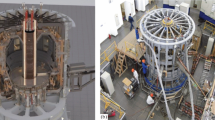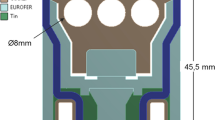Abstract
Prototypes of lithium emitters and collectors designed on the basis of capillary-porous systems (CPS) are being tried-out at the T-11M tokamak within the concept of continuous lithium circulation, previously proposed for stationary fusion neutron sources (FNSs). One of the goals of the T-11M tokamak research program are to implement the closure of the lithium circulation circuit and to develop the technology of recuperation (extraction and removal from the tokamak chamber) of hydrogen isotopes by using special lithium CPS-based collectors in order to prevent hydrogen isotope accumulation on the inner surface of the discharge chamber. In order to determine the optimal temperature regime for the future FNS operation, the effect of the temperature of the collector surface on its ability to capture lithium and hydrogen isotopes was studied. It is ascertained that the efficiency of capturing lithium and hydrogen isotopes by metal (12Cr18Ni10Ti) collectors in the operating regimes of the T-11M tokamak depends on the temperature of their collecting surfaces; namely, it remains almost constant in the temperature range from–196 to 50°С and then gradually decreases as the temperature rises to 300–400°С. In this case, the amount of the collected lithium is reduced by no more than sixfold, whereas the amount of collected hydrogen isotopes decreases by more than two orders of magnitude. Thus, the wall of a tokamak reactor chamber, which will be heated to 400°С but still coated with residual lithium (or its chemical compounds), will serve as a “mirror” for the incident hydrogen isotopes. It is found that the liquid lithium surface of the CPS-based collector can efficiently capture hydrogen isotopes falling onto it. As the lithium CPS-based collector is heated from 100 to 240°С, the amount of captured deuterium is reduced only twofold. This means that, in a steady-state mode, if, e.g., an MHD pump is used to transport liquid lithium from the collector back to the emitter, then, together with lithium, the captured hydrogen isotopes can also be transported into the recuperation zone.
Similar content being viewed by others
References
V. A. Evtikhin, I. E. Lyublinski, A. V. Vertkov, S. V. Mirnov, V. B. Lazarev, N. P. Petrova, S. M. Sotnikov, A. P. Chernobai, B. I. Khripunov, V. B. Petrov, D. Y. Prokhorov, and V. M. Korzhavin, Plasma Phys. Controlled Fusion 44, 955 (2002).
S. V. Mirnov, J. Nucl. Mater. 390−391, 876 (2009).
S. V. Mirnov, A. M. Belov, N. T. Djigailo, A. S. Dzhurik, S. I. Kravchuk, V. B. Lazarev, I. E. Lyublinski, A. V. Vertkov, M. Yu. Zharkov, and A. N. Shcherbak, Nucl. Fusion 55, 123015 (2015).
M. Yu. Zharkov, A. V. Vertkov, I. E. Lyublinskii, V. A. Vershkov, A. V. Karpov, and S. V. Mirnov, in Proceedings of the XX Conference on Plasma−Surface Interaction, Moscow, 2017, Ed. by Yu. M. Gasparyan, V. A. Kurnaev, A. S. Shubina, and D. S. Sinel’nikov (NRNU MEPhI, Moscow, 2017), p. 46.
E. A. Azizov, A. G. Alekseyev, A. V. Vertkov, V. A. Evtikhin, V. B. Lazarev, I. E. Ljublinski, S. V. Mirnov, V. M. Nesterenko, A. V. Parakhnuk, and R. R. Khairutdinov, in Proceedings of the 36th EPS Conference on Plasma Physics, Sofia, 2009, ECA 33E, P5.192 (2009).
S. V. Mirnov, N. T. Dzhigailo, and A. N. Shcherbak, Vopr. At. Nauki Tekh., Ser. Termoyad. Sintez 41 (1), 53 (2018).
Y. Furuyama, K. Ito, S. Dohi, A. Taniike, and A. Kitamura, J. Nucl. Mat. 313−316, 288 (2003).
M. J. Baldwin, R. P. Doerner, S. C. Luckhard, and R. W. Conn, Nucl. Fusion 42, 1318 (2002).
V. B. Lazarev, A. S. Dzhurik, A. N. Shcherbak, and A. M. Belov, Fusion Eng. Des. 112, 293 (2016).
A. Shcherbak, S. Mirnov, A. Dzhurik, V. Lazarev, Ya. Vasina, V. Otroshchenko, A. Vertkov, M. Zharkov, and I. Lyublinski, in Proceedings of the 44th EPS Conference on Plasma Physics and Controlled Fusion, Belfast, 2017, ECA 41F, P5.112 (2017).
J. P. Allain, PhD Thesis (University of Illinois at Urbana-Champaign, Urbana, IL, 2001).
Author information
Authors and Affiliations
Corresponding author
Additional information
Original Russian Text © A.N. Shcherbak, S.V. Mirnov, A.S. Dzhurik, V.B. Lazarev, Ya.A. Vasina, V.G. Otroshchenko, I.E. Lyublinski, A.V. Vertkov, M.Yu. Zharkov, 2018, published in Fizika Plazmy, 2018, Vol. 44, No. 11, pp. 855–863.
Rights and permissions
About this article
Cite this article
Shcherbak, A.N., Mirnov, S.V., Dzhurik, A.S. et al. Experiments on the Capture of Li, H, and D by Lithium Collectors at Different Surface Temperatures at the T-11M Tokamak. Plasma Phys. Rep. 44, 1001–1008 (2018). https://doi.org/10.1134/S1063780X18110090
Received:
Published:
Issue Date:
DOI: https://doi.org/10.1134/S1063780X18110090




